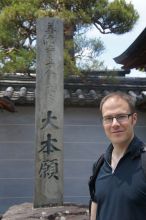Unconventional Economics: Debt and Fundraising by the Nuns of Zenkōji Daihongan in Eighteenth-century Japan
Matthew Mitchell - Graduate, Asian Religions, Duke University
The Council is pleased to present the 5th Stanley Weinstein Dissertation Prize Lecture.
Though a part of the popular pilgrimage temple Zenkōji, and the recipient of shogunal largesse and local taxes, by the middle of the eighteenth century, Daihongan convent was having difficulty paying for its operating costs. On top of this, irregular expenses, such as travel and maintenance to convent buildings exceeded the convent’s ability to pay using ordinary means. For these reasons, they began to turn extraordinary means to cover these expenses and remain a viable institution. I discuss these fundraising activities: loans, financial confraternities (tanomoshikō 頼母子講 or mujinkō 無尽講), displays of temple treasures (kaichō 開帳), and lotteries (tomitsuki 富突). Each of these activities sheds light on a different aspect of Daihongan’s use of convent legends, connections with common and elite laypeople, and its administrative structure. By combining the different views of the convent that these activities provide, a single image comes into focus: the diverse nature of Daihongan’s financial activities and the necessity of these activities for the convent to cover irregular expenses. These activities became especially important for the convent in the last half of the Edo period because although temples such as Zenkōji, Daihongan, and a number of other institutions that could demonstrate connections to the shogunate could rely upon the largesse of the bakufu in the first half of the Tokugawa period, by the middle portion of the period, the bakufu shifted responsibility for these repairs onto the temples themselves who then had to raise the funds through bakufu-approved methods such as displays, lotteries, and other means. Through this discussion, we also see how some in the period thought about the combination of Buddhism and money.
Matthew Mitchell is a graduate from the Asian Religions Track of Duke University’s Graduate Program in Religion. His research is focused on a group of Buddhist nuns of the Daihongan sub-temple of Zenkōji in Japan’s early modern period. His research in Japan and writing have been funded by the Japan Foundation’s Dissertation Fellowship, the Anne T. and Robert M. Bass Fellowship for Undergraduate Instruction, and the Robert H.N. Ho Family Foundation Dissertation Fellowship. He received his MA from the Religion Department of the University of Hawai’i at Mānoa.
The Stanley Weinstein Dissertation Prize was established in 2008 to honor Professor Weinstein’s many contributions to the study of East Asian Buddhism in North America. The prize is awarded once every two years to the best Ph.D. dissertation on East Asian Buddhism written in North America during the two previous years. The dissertation must be based on original research in the primary languages and should significantly advance our understanding of East Asian Buddhism. East Asian Buddhism is understood for this competition to refer to those traditions in East Asia that take Chinese translations of the Buddhist scriptures as their basis (Chinese, Japanese, Korean, and Vietnamese).

